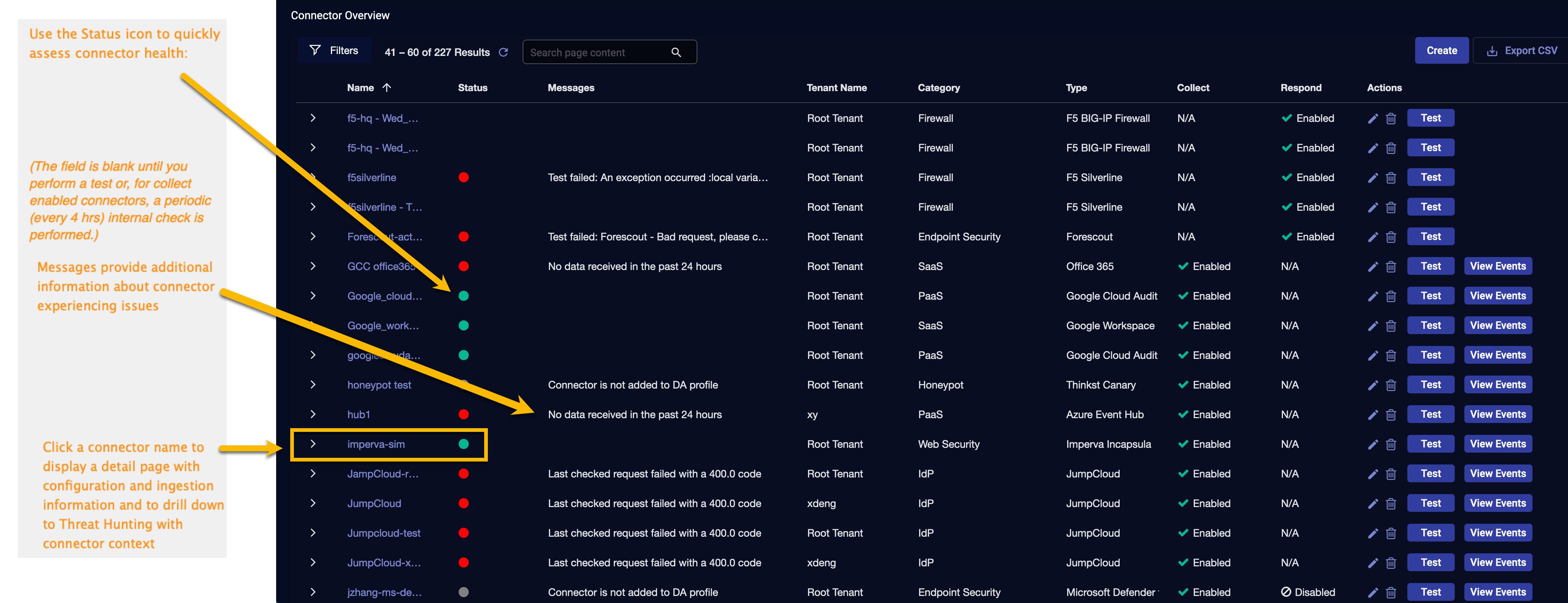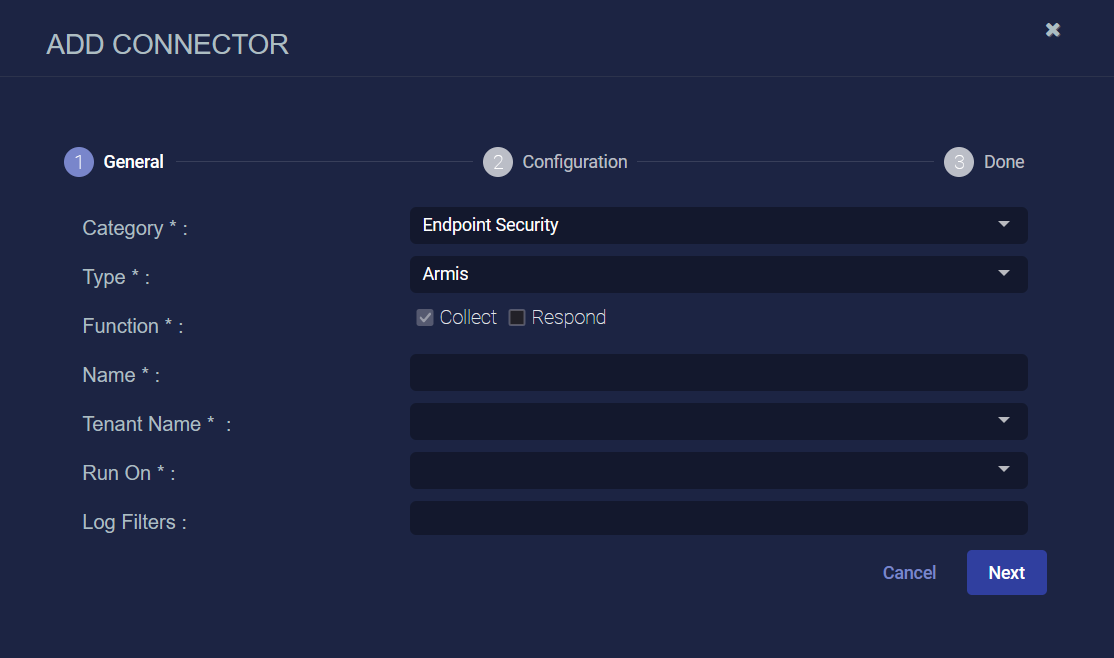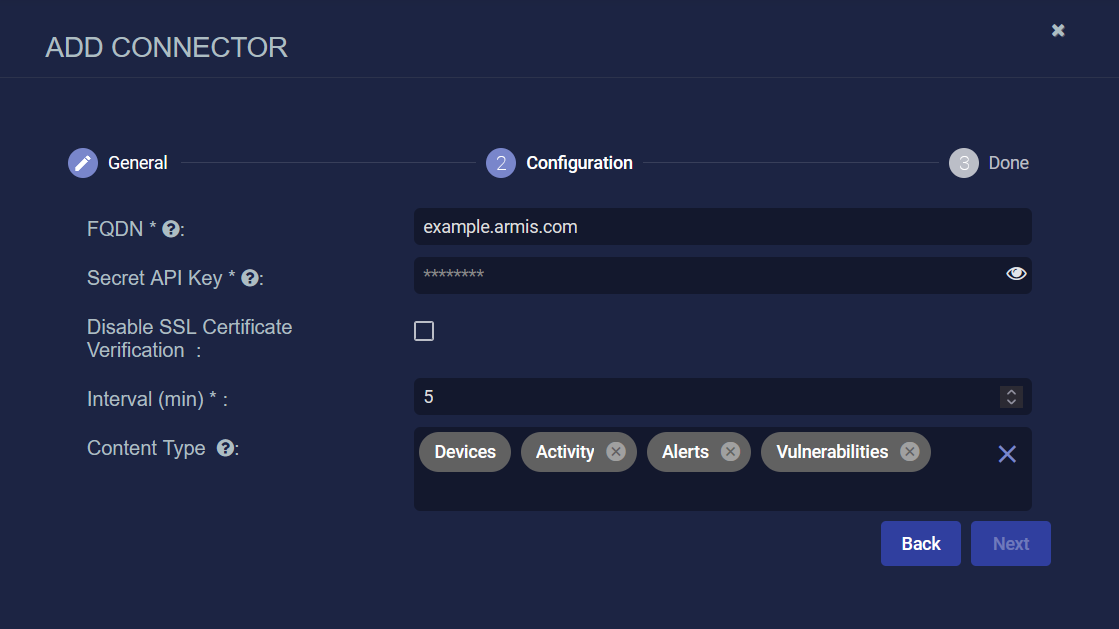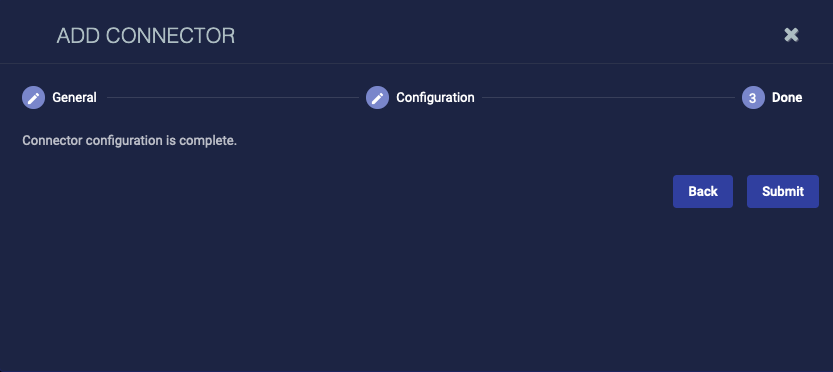Configuring Armis Connectors
This connector allows Stellar Cyber to ingest logs from Armis and add the records to the data lake. This connector integrates with the Armis API to query data for several content types.
Stellar Cyber connectors with the Collect function (collectors) may skip collecting some data when the ingestion volume is large, which potentially can lead to data loss. This can happen when the processing capacity of the collector is exceeded.
Connector Overview: Armis
Capabilities
-
Collect: Yes
-
Respond: No
-
Native Alerts Mapped: No
-
Runs on: DP
-
Interval: Configurable
Collected Data
|
Content Type |
Index |
Locating Records |
|---|---|---|
|
Activity Alerts Applications Business Applications Connections Devices Operating Systems Risk Factors Vulnerabilities |
Syslog Assets (for Devices) Scans (for Vulnerabilities) |
Domain
|
<FQDN> where <FQDN> is a variable from the configuration of this connector |
Response Actions
N/A
Third Party Native Alert Integration Details
N/A
Required Credentials and Configurations
-
FQDN and Secret API Key
Adding an Armis Connector
To add an Armis connector:
Obtaining Armis Credentials
Before you configure the connector in Stellar Cyber, you must obtain the following Armis credentials:
-
FQDN: Fully Qualified Domain Name of the instance URL from Armis. It has the format <instance-name>.armis.com.
To get the instance name, have an Armis service and get the URL from Armis. -
Secret API Key: A token generated from the Armis API Management page.
To get the Secret API Key, log in to your Armis instance and generate the key as follows:
Settings > API Management > Create
The token from Armis is valid for 15 minutes. The connector will try to refresh the token three (3) minutes before it expires.
Note that only one bearer token can be generated at a time with the API token. A consecutive call to get a bearer token will invalidate the previous bearer token.
Adding the Connector in Stellar Cyber
To add an Armis connector in Stellar Cyber:
-
Log in to Stellar Cyber.
-
Click System | Connectors (under Integrations). The Connector Overview appears.
-
Click Create. The General tab of the Add Connector screen appears. The information on this tab cannot be changed after you add the connector.
The asterisk (*) indicates a required field.
-
Choose Endpoint Security from the Category drop-down.
-
Choose Armis from the Type drop-down.
-
For this connector, the supported Function is Collect, which is enabled already.
-
Enter a Name.
Notes:- This field does not accept multibyte characters.
- It is recommended that you follow a naming convention such as tenantname-connectortype.
-
Choose a Tenant Name. The Interflow records created by this connector include this tenant name.
-
Choose the device on which to run the connector.
-
(Optional) When the Function is Collect, you can apply Log Filters. For information, see Managing Log Filters.
-
Click Next. The Configuration tab appears.
The asterisk (*) indicates a required field.
-
Enter the FQDN you noted above in Obtaining Armis Credentials.
Do not include the https prefix or a trailing "/" symbol.
-
Enter the Secret API Key you noted above.
-
(Optional) Click Disable SSL Certificate Verification if you want to disable SSL certificate verification. Only disable SSL certificates if you have a reason to, otherwise, it is not a good security practice.
-
Choose the Interval (min). This is how often the logs are collected.
-
Choose the Content Type you would like to collect. The following logs are supported.
-
Activity
-
Alerts
-
Applications
-
Business Applications
-
Connections
-
Devices
-
Operating Systems
-
Risk Factors
-
Vulnerabilities
The Devices content type is always selected and cannot be removed from the configuration as it is required for host information.
-
-
Click Next. The final confirmation tab appears.
-
Click Submit.
The new connector is immediately active.
Testing the Connector
When you add (or edit) a connector, we recommend that you run a test to validate the connectivity parameters you entered. (The test validates authentication and connectivity).
For connectors running on a sensor, Stellar Cyber recommends that you allow 30-60 seconds for new or modified configuration details to be propagated to the sensor before performing a test.
-
Click System | Connectors (under Integrations). The Connector Overview appears.
-
Locate the connector by name that you added, or modified, or that you want to test.
-
Click Test at the right side of that row. The test runs immediately.
Note that you may run only one test at a time.
Stellar Cyber conducts a basic connectivity test for the connector and reports a success or failure result. A successful test indicates that you entered all of the connector information correctly.
To aid troubleshooting your connector, the dialog remains open until you explicitly close it by using the X button. If the test fails, you can select the button from the same row to review and correct issues.
The connector status is updated every five (5) minutes. A successful test clears the connector status, but if issues persist, the status reverts to failed after a minute.
Repeat the test as needed.
If the test fails, the common HTTP status error codes are as follows:
| HTTP Error Code | HTTP Standard Error Name | Explanation | Recommendation |
|---|---|---|---|
| 400 | Bad Request | This error occurs when there is an error in the connector configuration. |
Did you configure the connector correctly? |
| 401 | Unauthorized |
This error occurs when an authentication credential is invalid or when a user does not have sufficient privileges to access a specific API. |
Did you enter your credentials correctly? Are your credentials expired? Are your credentials entitled or licensed for that specific resource? |
| 403 | Forbidden | This error occurs when the permission or scope is not correct in a valid credential. |
Did you enter your credentials correctly? Do you have the required role or permissions for that credential? |
| 404 | Not Found | This error occurs when a URL path does not resolve to an entity. | Did you enter your API URL correctly? |
| 429 | Too Many Requests |
This error occurs when the API server receives too much traffic or if a user’s license or entitlement quota is exceeded. |
The server or user license/quota will eventually recover. The connector will periodically retry the query. If this occurs unexpectedly or too often, work with your API provider to investigate the server limits, user licensing, or quotas. |
For a full list of codes, refer to HTTP response status codes.
Verifying Ingestion
To verify ingestion:
-
Click Investigate | Threat Hunting. The Interflow Search tab appears.
-
Change the Indices for the type of content you collected:
-
For all content types except Vulnerabilities, change the Indices to Syslog.
-
For Vulnerabilities only, change the Indices to Scans.
-
For Devices only, change the Indices to Assets.
The table immediately updates to show ingested Interflow records.
-








